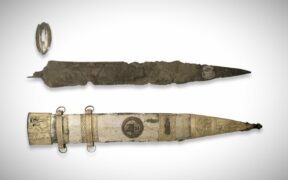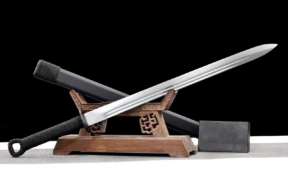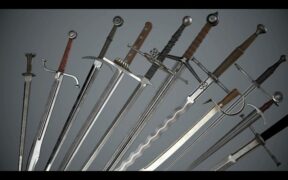Our content features commercial links to our products, committed to transparent, unbiased, and informed editorial recommendations. Learn More
Spatha 101: Dimensions, Types, and History of the Roman Long Sword
NO AI USED This Article has been written and edited by our team with no help of the AI
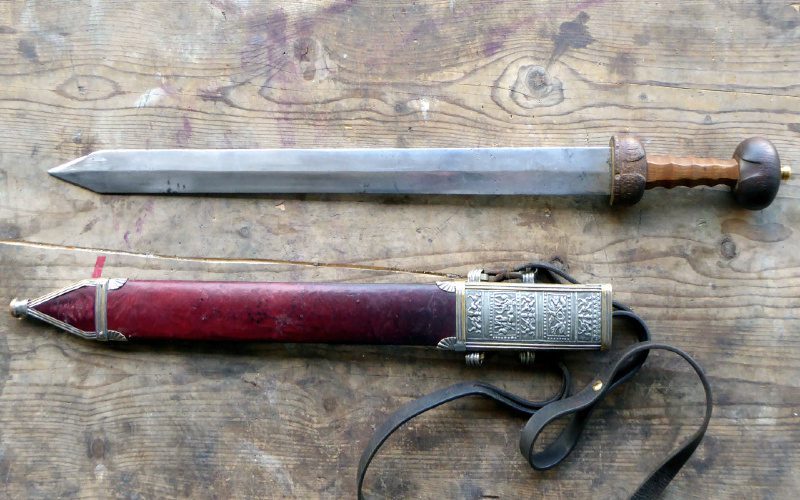
The Roman Spatha Sword was the most popular sword among Roman cavalrymen and infantry. It was a long, straight weapon used extensively in Roman battles and gladiator contests. Eventually, it was taken up by other tribes and developed into early medieval swords like the Carolingian or Viking sword, Arming or Knightly sword, and Longsword.
The short Gladius, which had previously dominated the ancient world and had an impact on all who lived during the Roman Empire, was eventually superseded by this longer Spatha model. This article discusses Spatha’s influence and efficacy as the most widely used and highly imitated weapon. We will discuss its characteristics, uses, and history and compare it to the earlier Gladius.
Characteristics of the Spatha Sword
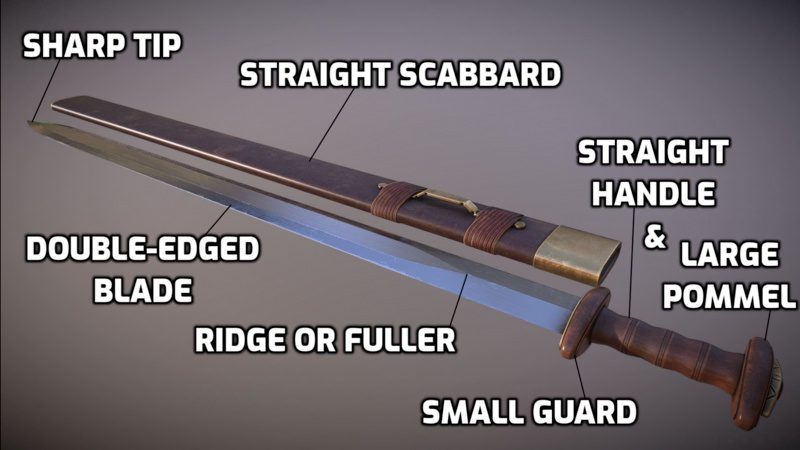
The Spatha Sword is a simple-looking double-edged bladed weapon that resembles the Roman Gladius but with added length. It has the feel and look of an ancient sword, but its characteristics changed with the centuries resulting in many types of the Spatha.
Blade
The Spatha is considered an ancient longsword with a straight and double-edged blade, which is sharpened on both sides to lacerate the opponent effectively. This straight blade tapers to a tip at the very end of the sword, giving it the ability to be effective in a deep piercing motion. Often the blade had a blunted or rounded tip so that Roman cavalrymen would not accidentally stab themselves or their horses.
The Spatha has a ridge at the center of the blade, extending toward the end, strengthening the blade. The blade is full-tang, extending through the handle down to the pommel. Some Spathas have fullers on them to make them lighter and faster.
The Roman Spatha blade was made out of iron, and with time, especially after the Roman conquest of Iberia and learning their manufacturing methods, with high carbon steel plates. These plates were welded to the blade separately, similar to that seen in Damascus steel pattern wielding. It was a high-quality flexible blade that could be bent like a bow without snapping in half.
Although the blade length could vary as there are shorter and longer Spatha swords, the most common blade length for the Spatha is in the range of 23 to 33 inches (60 to 85cm).
Guard
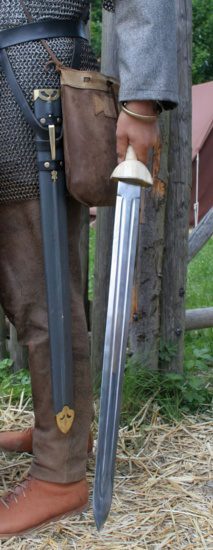
The Roman Spatha will occasionally feature a very small oval-shaped guard. It strongly resembles the Roman Sword, primarily the Gladius that it replaced, which did not feature a guard. When it was designed to be longer, however, some crossguards appeared that could provide some protection but mostly served as a stopping point for your hand, so it didn’t come in contact with the blade, especially when used for slashing strikes.
Handle
The Spatha Sword handle is straight and can vary in shape and size depending on the period. The usual length is around 6 to 8 inches (15 to 20 cm). Most have hand ridges, giving the weapon a stronger grip. The highly decorated handle was made mostly out of wood or bone.
Pommel
The Spatha has a large pommel with 1.7 to 2.3 inches (4 to 6 cm) in width and length, which is also a trait of the previous Gladius. This serves as a back support for the hand as well as holding the blade tang more firmly. The reason for its massive size is that it was designed to bash enemies during close combat. The pommel could be decorated, and if it were used by a commanding officer, it would feature the Roman eagle.
Scabbard
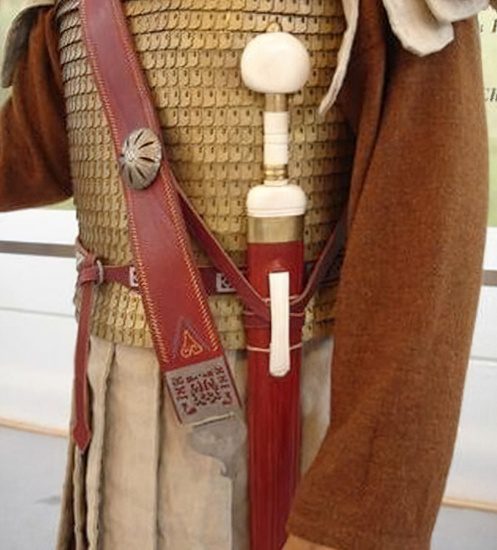
According to many archeological finds, the scabbard of the Spatha is the same as the Roman sword Gladius. They were straight and could be made of wooden planks, leather, metal, or ivory.
The ones used by commanding troops had special designs and writings like Roman insignia symbols and the rank of the officers, while the regular soldier’s scabbards were mostly blank.
The Spatha was carried in its scabbard on the waist belt and then placed on the right side of the sword belt.
Length
The Spatha Sword was commonly between 20 to 40 inches (50 to 100 cm) long, depending on the period. The size also varied as there were short and long Spatha swords, but it was usually within the above-mentioned range. The width of the Spatha is 1.5 to 2.3 inches (4 to 6 cm).
Weight
The weight of the Spatha Sword also depended on the period and style of their creation. For example, the late Roman Spatha would have been much heavier than those initially designed. However, in any case, the sword was still a very light sword used by the Roman legionary to deliver swift strikes. The overall weight of the Spatha Sword is 1.5 lbs to 3.3 lbs (0.7 to 1.5 kg).
Variations of the Spatha Sword
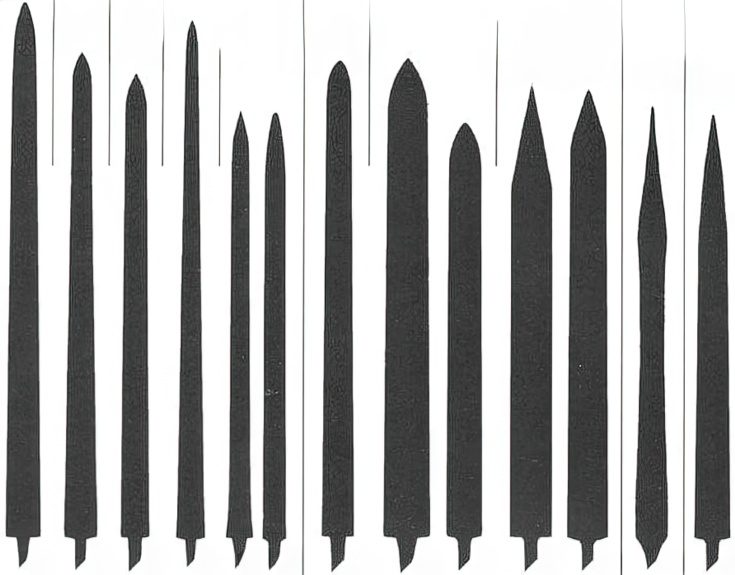
There are no clear-cut designs of the Spatha Sword as some historians referred to them as Viking Spatha, Norman Spatha, Roman, and even Byzantine Spatha, depending on the time frame in history they were used.
In the Spatha period, they were called a “sword” or a broad sword. The terminology comes from 19th-20th-century sword enthusiasts and historians so we won’t place the Carolingian Sword in different categories.
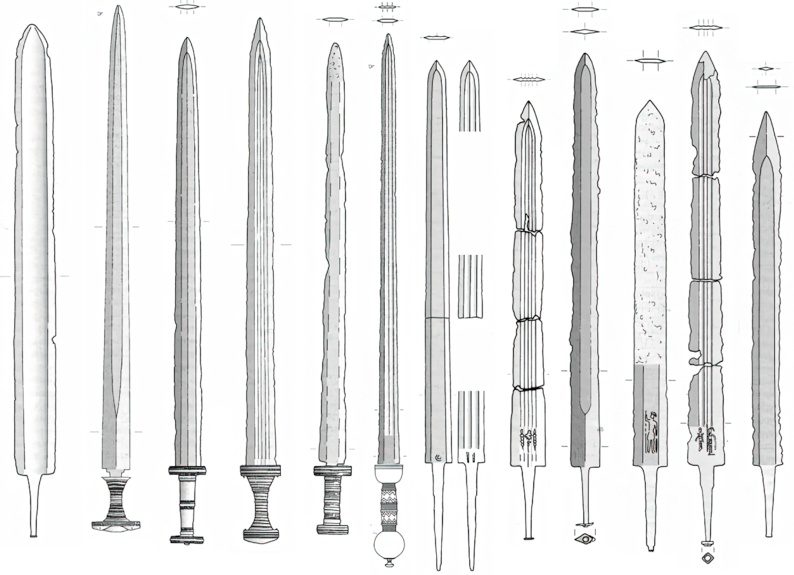
The Spatha underwent many different variations throughout time and geographical regions. For example, the first-century BC Spatha differs from the third-century AD Spatha. Some were a little larger than the Gladius short sword, while others were double the size.
The blade shapes and lengths were different, and they had a fuller or blade ridges. Some even had very thin, straight blades in the form of a Rapier. Their handles also changed with time, eventually leading to the European swords’ birth.
Use of the Spatha Sword
The Spatha Sword is a one-handed weapon used primarily while on horseback or with time as the main infantry weapon for the Romans and other European peoples. It is a light weapon that was best combined with a shield for attacking a formation of soldiers.
Although the previous Gladius was made primarily for stabs, the Spatha could be used for severing body parts of the enemy and, by some, is considered mainly a slashing weapon.
Warfare & Combat
The Spatha saw a lot of combat and was used to aid in the fight against many different enemy tribes in battle, including the Huns. The Spatha started as a cavalry weapon and later sabres used by the auxiliary forces. With time it changed into the primary weapon of the infantry as well since it had proved worthy in hard combat.
Rank Defining

The Romans had the majority of their success thanks to the organization and discipline in battles given by their commanders. The scutum (shields) had numbers and legion symbols, so the soldiers knew what platoon they should be in.
Because the Spatha was a rank-defining weapon, those used by the commanding units or officers had decorated Spatha swords with rare and expensive materials such as ivory. As mentioned above, the pommel on an officer’s sword often depicted the Roman eagle.
Today the Spatha Sword is one of the most popular weapons next to the Gladius Sword used for reenactment and LARP of the Roman soldiers in battle. It is also a straight sword that can be used for sparring and training.
History of the Spatha Sword
The Greek word “σπάθη” (spáthē) is the source of the Latin term “spatha,” which refers to broadswords and blades of any material. The term for sword in Italian and Romanian is spada; in Portuguese and Spanish, it is espada. In Albanian, it means shpate, and so on. These names derive from either the ancient Greek word or possibly a Celtic term, as some historians believe.
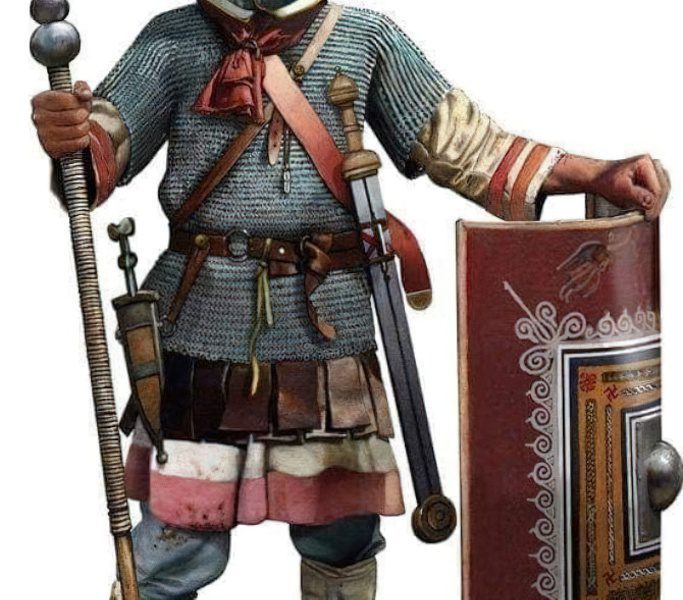
For some, the longer Spatha was just an improvement over the Roman Gladius. In contrast, others believe it was brought to Rome by the Celtic cavalry auxiliary, who carried traditional swords with greater reach for better effectiveness on horseback.
Some historians believe that Rome adopted and learned from Iberian metallurgy after its conquest of Iberia, allowing it to create longer blades. As a result, Spatha Swords were subsequently adopted by Roman foot and cavalry soldiers and used throughout the Roman military.
These longer swords of the La Tene type (previous European or Celtic longswords) were first seen in the Roman army in the late 1st century BC, especially by the Gallic cavalry who served among them.
The Spatha, however, started being widely used by the Roman cavalry in the 1st century, and by the 2nd and 3rd centuries, it became the standard sword of Rome’s heavy infantry. It was then relegated to the role of sidearm for light infantry, while the cavalry variant had a round tip to avoid accidental stabbing of the rider’s foot or his horse.
During the Great Migration of Peoples, the legendary Carolingian Sword was developed from the long Roman Weapon Spatha. It served as the foundation for the Germanic Carolingian Sword. The convergence on the blade did not need to be made even more acute since iron armor was not used throughout the early middle ages. The blades of swords were made to be broad and were designed primarily for cutting strikes.
Gradually, it evolved into the Carolingian Sword, known as the Viking Sword, with the fall of the Western Roman Empire. In the Eastern Roman Empire, the Spatha Sword, sometimes called Migration Sword, survived and was used in the Byzantine army throughout its existence. It was so effective that the Byzantines even had a title for its bearers, “spatharios,” meaning “bearer of the spatha,” as a royal court title.
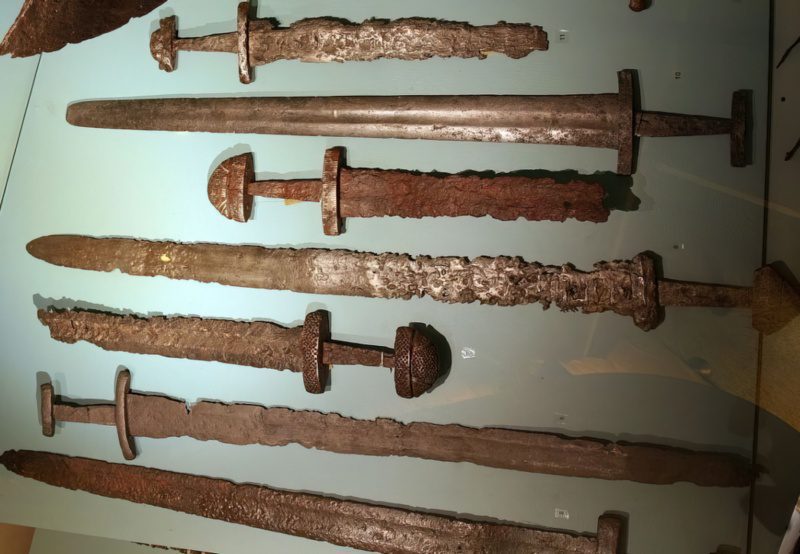
The Spatha saw many designs throughout its years of use. Its original design has influenced many later European Swords and is also the direct predecessor of many popular swords today. In time it was modified and replaced, especially with the coming of the Carolingian and then the Arming Sword.
Why Did the Spatha Overtake the Gladius?
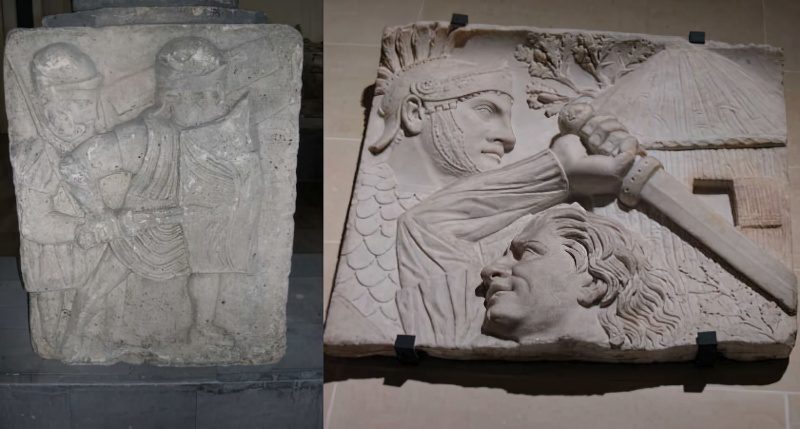
The biggest difference between the Roman Spatha and Gladius is the length and weight. To find direct differences and compare whether the Gladius or the Spatha is a better sword, one needs to look not only at the armaments or styles of battles but instead the time period and the daily surroundings.
The Spatha was generally used in the hands of the Roman infantry and cavalry in the late Roman Period when the brutality of war had become commonplace. It was a completely different world from the wealth and splendor of the younger Roman Empire.
The tactical approach of the Romans now completely changed from offensive only to defensive only, and they needed to approach many frontiers simultaneously with the aid of the cavalry. Being on horseback meant one needed extra reach, which was a huge advantage of the Spatha Sword. Also, many battles against the “barbarians” (tribes attacking Rome) weren’t as organized as fighting with a Gladius and a scutum formation.
With time the auxiliary troops were abundant in the Roman Empire, all of which used the longer swords from before, as wielding the long Spatha came naturally to the cavalry and the infantry. That is why the longer Spatha basically overtook and completely replaced the Gladius.
Conclusion
Not only did Spatha swords play an important part in the history of Rome, but they also served as a source of innovation for a variety of other civilizations and cultures over the years. Since it was instrumental in establishing several empires and their eventual demise, the opportunity to acquire one and own a piece of history as the Spatha is unquestionably a privilege.
